HP Unveils Spectre: The World’s Thinnest Laptop
by Anton Shilov on April 5, 2016 11:59 AM EST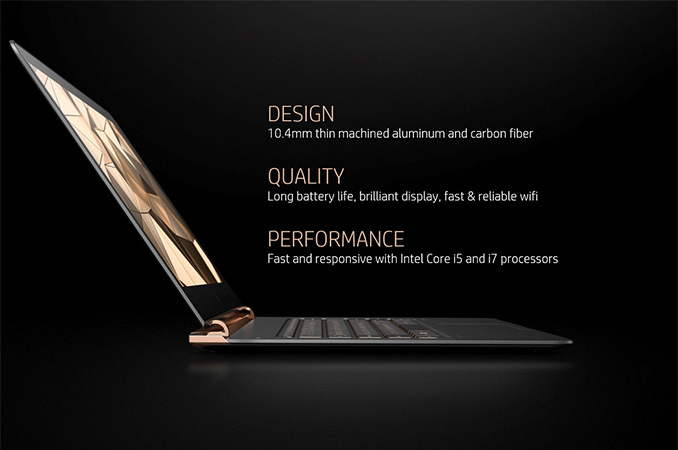
HP has announced its new Spectre laptop - the world’s thinnest 13.3” notebook. Despite its miniature size, the Spectre uses Intel’s Core i5/i7 microprocessor, a PCIe-based SSD, a full-size keyboard as well as an advanced audio system developed by Bang & Olufsen. To build its new notebook, HP had to use a number of innovative technologies, although to make the system so small and thin it had to sacrifice upgradeability and serviceability. On top of it all, the HP Spectre comes across as very price competitive.
The HP Spectre is just 10.4 mm thick and weighs 1.10 kilograms (2.45 lbs). To build it, HP had to use CNC-machined anodized aluminum and combine it with carbon fiber, a custom display panel with Gorilla Glass 4 as well as special recessed piston hinges. To maximize battery life (which is officially listed at 9 hours 30 minutes), HP had to use two types of batteries of different shapes inside its Spectre laptop, giving four cells in total. As part of a premium line, it comes in black and gold finish as well as with a different varient of HP’s logo, emphasizing the position of the system.
The HP Spectre laptop is based on the Core i5-6200U (two cores with Hyper-Threading, 3 MB L3 cache, Intel HD Graphics 520) or the Core i7-6500U (two cores with Hyper-Threading, 4 MB L3 cache, Intel HD Graphics 520), but the manufacturer does not disclose exact clock-rates of the CPUs. HP notes that the microprocessors may not necessarily work at their default frequencies all the time, but indicates that the chips are still considerably faster than the Core M processors used inside the Apple MacBook. These could either be the full fat 15W parts, or the models could be in cTDP down mode.
| Comparison of Ultra-Thin Notebooks | ||||
| HP Spectre | Apple MacBook (2015) | ASUS UX305UA | ||
| Screen Resolution | 1920×1080 | 2304×1440 | 1920×1080 3200×1800 |
|
| CPU | Intel Core i5-6200U Intel Core i7-6500U |
Intel Core M 1.1 GHz Intel Core M 1.2 GHz Intel Core M 1.3 GHz |
Intel Core i3-6100U Intel Core i5-6200U Intel Core i7-6500U |
|
| Graphics | Intel HD Graphics 520 (24 execution units) |
Intel HD Graphics 5300 (24 EUs) | Intel HD Graphics 520 (24 execution units) |
|
| RAM | 8 GB (LPDDR3?) | 8 GB LPDDR3 | 4 GB LPDDR3 8 GB LPDDR3 |
|
| Storage | 256 GB SSD 512 GB SSD |
256 GB SSD 512 GB SSD |
128 GB SSD 256 GB SSD 512 GB SSD |
|
| Wi-Fi | Wi-Fi | 802.11ac Wi-Fi | 802.11ac Wi-Fi | |
| USB | 3.1 | 3 × Type-C | - | - |
| 3.0 | - | 1 × Type-C | 2 × Type-A | |
| 2.0 | - | - | 1 × Type-A | |
| Thunderbolt | 2 × Thunderbolt 3 | - | - | |
| HDMI | - | - | micro-HDMI | |
| Other I/O | Microphone, stereo speakers, audio jack | |||
| Thickness | 10.4 mm | up to 13.1 mm | 16 mm | |
| Weight | 1.10 kilograms | 0.92 kilograms | 1.30 kilograms | |
| Price | 256GB: $1170 (Core i5) $1250 (Core i7) |
256GB: $1300 (1.1 GHz) $1600 (1.3 GHz) |
$750 - $1200 | |
To cool-down the CPUs, HP uses its so-called 'hyperbaric cooling technology', which features two ultra-thin fans, a heat-pipe as well as a special copper radiator. The fans intake cool air from the outside and create significant air pressure inside the chassis to blow away hot air. The company does not disclose how loud such cooling system is, but implies that noise levels created by the Spectre should be comfortable.
The Spectre is equipped with 8 GB of memory (we believe LPDDR3) that is soldered to the motherboard, which means that it cannot be upgraded. The notebook is also equipped with a standard 256 GB or 512 GB SSD, but HP does not release performance figures or which model this is. The company also says that since the design of its laptop is “sealed”, it is impossible to upgrade the storage drive at home, suggesting a soldered down version of an M.2 drive. Keeping in mind that it is impossible to add storage to the majority of tablets and 2-in-1 hybrid PCs, it is not surprising that HP chose to limit upgrade capabilities of its Spectre notebook. When creating Spectre, HP focused mostly on making an extremely thin design, but not to offer capabilities for further modernization.
Due to thin design and relatively limited battery capacity of the HP Spectre, the manufacturer did not have much choice when it comes to display panels. HP uses a 13.3” full-HD (1920×1080) IPS panel with 300 nits brightness, which covers 72% NTSC. According to HP, the panel provides the right balance between resolution, power consumption, the brightness, and the price. Nevertheless, the most important feature of the panel is its thinness. The whole display assembly is just 2 mm thick.
The HP Spectre also comes with three USB type-C ports, two of which support Thunderbolt 3. These will be powered by Intel's Alpine Ridge controller, though HP has not disclosed how many are in use (either one controller for both ports, or two controllers for one each). The TB3-enabled ports can be used to connect external displays as well as Thunderbolt 3 peripherals. It is noteworthy that since HP does not talk about connecting things like external graphics adapters to its Spectre notebooks, this feature may not be enabled right now.
The notebook is also equipped with a keyboard that has 1.3 mm travel as well as a trackpad with full-travel etched glass. HP compares it Spectre to Apple’s MacBook and claims that the keyboard, as well as the touchpad of the MacBook, are less comfortable to use than those on the HP machine, something that needs to be verified by independent reviews.
Communication capabilities of the HP Spectre include a Wi-Fi and Bluetooth module that supports 2.4 GHz and 5 GHz networks. The module supports only one “slot” antenna, therefore, its performance may be lower when compared to other modern notebooks, another thing that HP may have had to sacrifice for portability. HP also does not specify if the Wi-Fi is 802.11ac or 802.11n only.
This month HP will begin to sell its Spectre laptop at hp.com as well as at Best Buy in the U.S. The Spectre based on the Intel Core i5-6200U and equipped with 8 GB of RAM and 256 GB SSD will cost $1169.99, whereas the model featuring the Intel Core i7-6500U, 8 GB of memory and a 256 GB SSD will be priced at $1249.99. There is no word on the cost of the 512GB models as of yet, although we expect another $100-$150 on top of that. In May, the manufacturer plans to start selling its thinnest laptop in other countries, but it does not reveal the list of countries or recommended prices. In the US, HP will also offer limited edition systems co-developed with famous designers combining a golden finish and Swarovski crystals. In addition, the company will also sell accessories (a Bluetooth mouse, a carry bag and a leather sleeve) that match the design of the Spectre notebook.
Source: HP


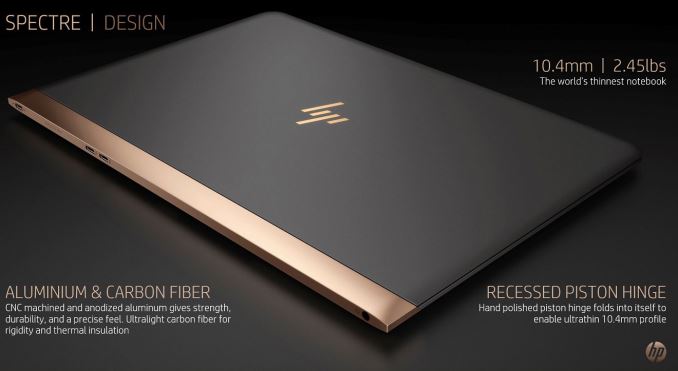
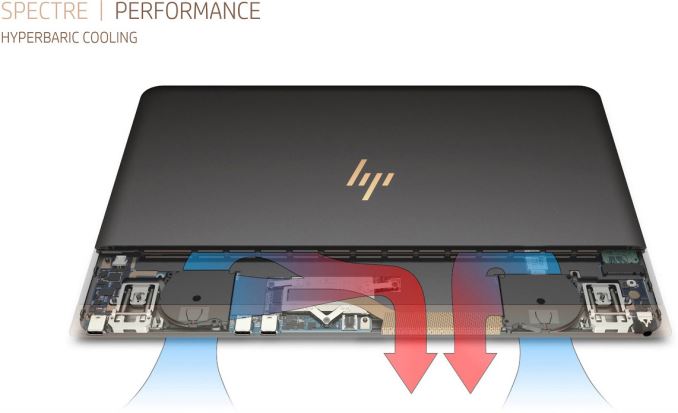
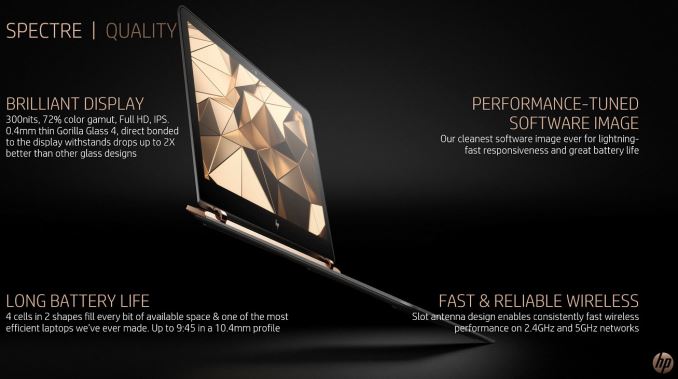
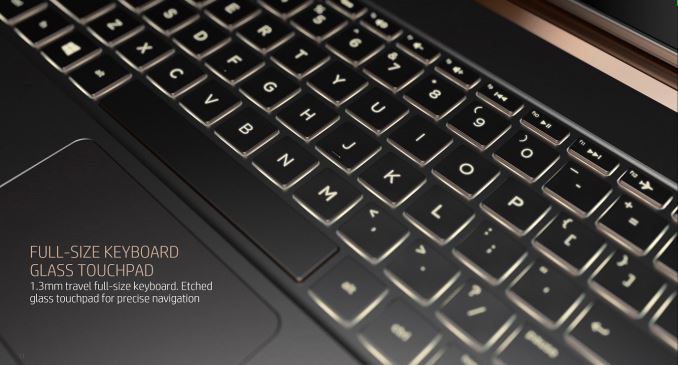









75 Comments
View All Comments
contact_feanor - Sunday, May 8, 2016 - link
You can't disprove his "apple said..." by showing just one article about something apple said. "all swans are white" isn't true because you couldn't find a black swan.Here's the article he was referring to: https://support.apple.com/en-us/HT204639
and they specifically mention to use running water on the watch.
Guess he wasn't "blatantly lying and spreading bullshit" after all. Maybe you ought to stop?
tuxRoller - Thursday, April 7, 2016 - link
Who mentioned enterprise and the necessity of milspec?I'm talking about how well the systems are manufactured such that keyboards, ports, screens, track pads remain in good shape after years of use. This is contrasted with lenovo, who have laptops that meet milspec, but the damn things fall apart after a couple of years.
I notice you didn't say anything about battery life.
Btw, I don't own, and don't plan on every purchasing, any Apple products. My experience with these two manufacturers comes from friends and business.
Samus - Friday, April 8, 2016 - link
It's funny you mention Lenovo. As they have slowly tanked what they purchased from IBM and completely embarrassed the Thinkpads nameplate they have actually lost most of their MIL STD accreditations. The current T series meets 4 of the 10 criteria. None for durability.tuxRoller - Saturday, April 9, 2016 - link
I mentioned lenovo as that's what I'm most familiar with, and they have a page that says "Selected ThinkPad models, including all X & T series, have successfully passed the following tests [eight tests are listed]". However, they don't say how many tests any particular model has passed.Regarding the spec itself, there doesn't appear to be any single test that corresponds to "durability"(https://en.m.wikipedia.org/wiki/MIL-STD-810#MIL-ST... and if you keep reading, you'll see that for consumers, there is "no commercial organization or agency certifies compliance" add it's up to the vendors to either perform these tests themselves out through a contracted third party. My last point is that the spec seems to "only" be concerned about environmental fitness. This is an important point as this would mean that "durability" really comes down to matching the intended use cases with which tests the device had passed. Iow, all 29 tests of milspec 810g are about durability.
name99 - Tuesday, April 5, 2016 - link
One day the mythical ARM-Mac will arrive (I expect before 2020) and at that point I also expect we will have the equivalent performance gap (at least in laptops) that we see with iPhones vs everyone else.But yeah, today, when you're using parts like everyone else, you get performance like everyone else.
The number that's conspicuously lacking the review is how long the battery lasts. My guess is that THAT is the Achilles heel. Apple has targets for battery life (which seem to be something like 1 day usage for all their devices under aggressive,but not extreme use) and I'm guessing that while they could have created something like this. they weren't willing to do so because of the battery life hit.
mrvco - Tuesday, April 5, 2016 - link
It says HP claims 9H 30M, but they are derating the proc by an unspecified amount to get that number.damianrobertjones - Wednesday, April 6, 2016 - link
You're forgetting history. Not all macbooks have had amazing battery life compared to the competition.sphigel - Tuesday, April 5, 2016 - link
Apple is still the king in terms of battery life as far as I can tell. I think the Dell XPS 13 did give the MacBook's a run for their money in active use battery life but Apple's standby battery life is an order of magnitude better than anyone else. I have a 13" rMBP and I can close the lid on it while it's powered on and I can come back to it two weeks later the the battery will drop 5%. I have a Surface Book 4 that can lose 20% in one day's worth of standby. Other PC laptops aren't much better from what I've seen.setzer - Tuesday, April 5, 2016 - link
Disable connected standby and all the things that don't work on osx but do work on windows and you will get similar suspend drain for similar components.Not that connected standby is really useful, if i have my lid closed i'm not really interested on checking my email, intel and microsoft think otherwise though...
sphigel - Tuesday, April 5, 2016 - link
Good call on disabling connected standby. I forgot about that. I'll give that a try as I also don't see the utility in it. I'm still doubtful that the standby battery life will be as good as a MacBook though because I've seen the same battery drain issues on PC laptops that don't have connected standby capabilities.